Critical Evaluation of Diversity in Australian Organizations: HRM
VerifiedAdded on 2022/08/26
|10
|3468
|17
Report
AI Summary
This report critically evaluates the issues Australian organizations face in maintaining a multicultural and ethnically diverse environment, focusing on Human Resource Management (HRM) practices. It addresses the increasing importance of organizational diversity, its impact on productivity, creativity, and employee behavior, referencing the "Victoria’s Equal Opportunity and Human Rights Commission 2019 report" highlighting a surge in racial discrimination complaints. The report discusses the benefits of workplace diversification, including mutual respect, economic empowerment, and enhanced organizational reputation. It examines challenges such as lack of respect, ethnic and cultural differences, and communication barriers. Furthermore, it explores the significance of diversity in the Australian workforce, with statistics on the diverse origins of the population. The report also identifies HRM challenges related to communication, employee adaptation, discrimination, and generational gaps, while also discussing the practices adopted by organizations to manage diversity.

Running head: Diversity in Organization
Diversity in Organization
Name of the University:
Name of the Student:
Author’s note:
Diversity in Organization
Name of the University:
Name of the Student:
Author’s note:
Paraphrase This Document
Need a fresh take? Get an instant paraphrase of this document with our AI Paraphraser
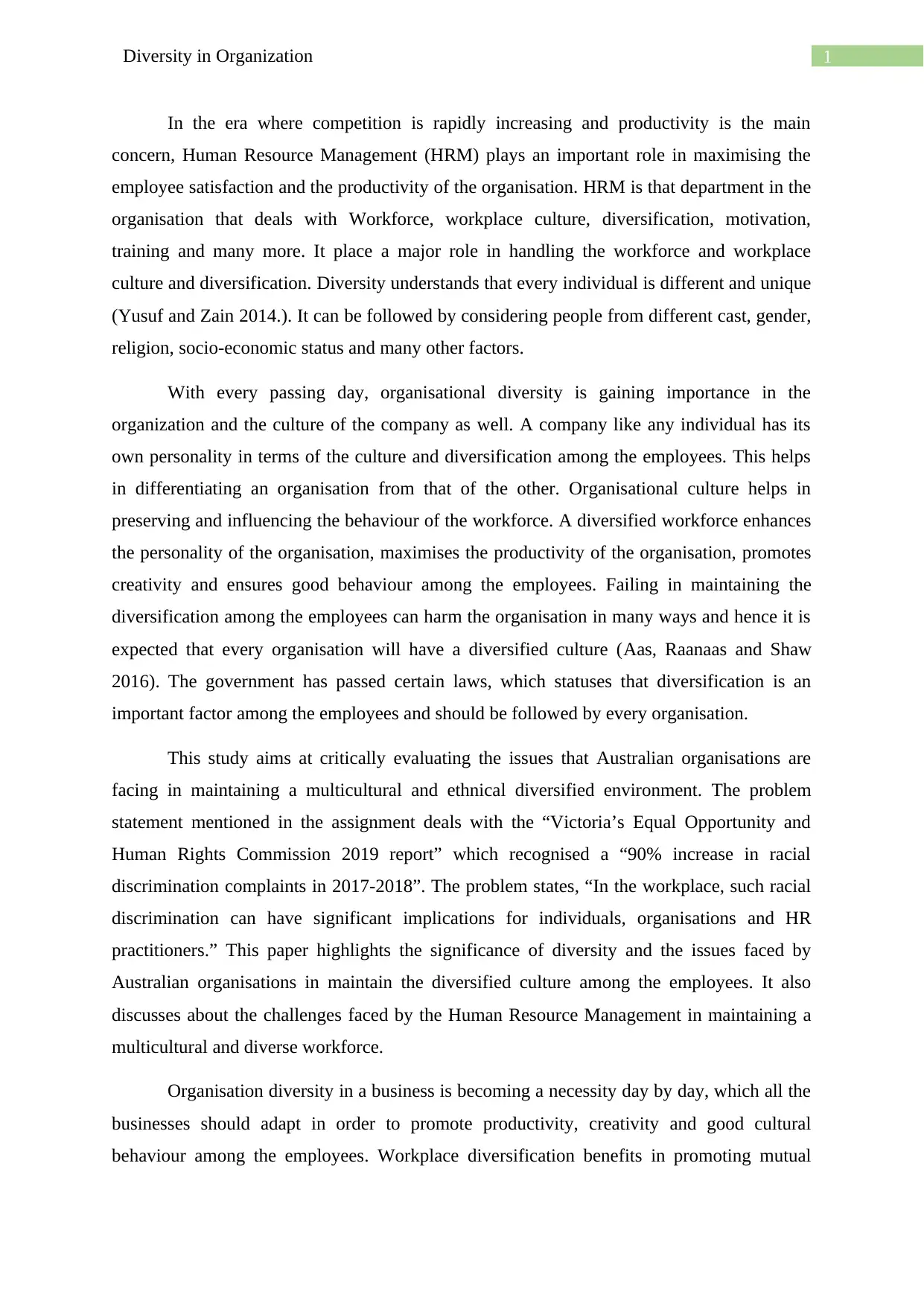
1Diversity in Organization
In the era where competition is rapidly increasing and productivity is the main
concern, Human Resource Management (HRM) plays an important role in maximising the
employee satisfaction and the productivity of the organisation. HRM is that department in the
organisation that deals with Workforce, workplace culture, diversification, motivation,
training and many more. It place a major role in handling the workforce and workplace
culture and diversification. Diversity understands that every individual is different and unique
(Yusuf and Zain 2014.). It can be followed by considering people from different cast, gender,
religion, socio-economic status and many other factors.
With every passing day, organisational diversity is gaining importance in the
organization and the culture of the company as well. A company like any individual has its
own personality in terms of the culture and diversification among the employees. This helps
in differentiating an organisation from that of the other. Organisational culture helps in
preserving and influencing the behaviour of the workforce. A diversified workforce enhances
the personality of the organisation, maximises the productivity of the organisation, promotes
creativity and ensures good behaviour among the employees. Failing in maintaining the
diversification among the employees can harm the organisation in many ways and hence it is
expected that every organisation will have a diversified culture (Aas, Raanaas and Shaw
2016). The government has passed certain laws, which statuses that diversification is an
important factor among the employees and should be followed by every organisation.
This study aims at critically evaluating the issues that Australian organisations are
facing in maintaining a multicultural and ethnical diversified environment. The problem
statement mentioned in the assignment deals with the “Victoria’s Equal Opportunity and
Human Rights Commission 2019 report” which recognised a “90% increase in racial
discrimination complaints in 2017-2018”. The problem states, “In the workplace, such racial
discrimination can have significant implications for individuals, organisations and HR
practitioners.” This paper highlights the significance of diversity and the issues faced by
Australian organisations in maintain the diversified culture among the employees. It also
discusses about the challenges faced by the Human Resource Management in maintaining a
multicultural and diverse workforce.
Organisation diversity in a business is becoming a necessity day by day, which all the
businesses should adapt in order to promote productivity, creativity and good cultural
behaviour among the employees. Workplace diversification benefits in promoting mutual
In the era where competition is rapidly increasing and productivity is the main
concern, Human Resource Management (HRM) plays an important role in maximising the
employee satisfaction and the productivity of the organisation. HRM is that department in the
organisation that deals with Workforce, workplace culture, diversification, motivation,
training and many more. It place a major role in handling the workforce and workplace
culture and diversification. Diversity understands that every individual is different and unique
(Yusuf and Zain 2014.). It can be followed by considering people from different cast, gender,
religion, socio-economic status and many other factors.
With every passing day, organisational diversity is gaining importance in the
organization and the culture of the company as well. A company like any individual has its
own personality in terms of the culture and diversification among the employees. This helps
in differentiating an organisation from that of the other. Organisational culture helps in
preserving and influencing the behaviour of the workforce. A diversified workforce enhances
the personality of the organisation, maximises the productivity of the organisation, promotes
creativity and ensures good behaviour among the employees. Failing in maintaining the
diversification among the employees can harm the organisation in many ways and hence it is
expected that every organisation will have a diversified culture (Aas, Raanaas and Shaw
2016). The government has passed certain laws, which statuses that diversification is an
important factor among the employees and should be followed by every organisation.
This study aims at critically evaluating the issues that Australian organisations are
facing in maintaining a multicultural and ethnical diversified environment. The problem
statement mentioned in the assignment deals with the “Victoria’s Equal Opportunity and
Human Rights Commission 2019 report” which recognised a “90% increase in racial
discrimination complaints in 2017-2018”. The problem states, “In the workplace, such racial
discrimination can have significant implications for individuals, organisations and HR
practitioners.” This paper highlights the significance of diversity and the issues faced by
Australian organisations in maintain the diversified culture among the employees. It also
discusses about the challenges faced by the Human Resource Management in maintaining a
multicultural and diverse workforce.
Organisation diversity in a business is becoming a necessity day by day, which all the
businesses should adapt in order to promote productivity, creativity and good cultural
behaviour among the employees. Workplace diversification benefits in promoting mutual
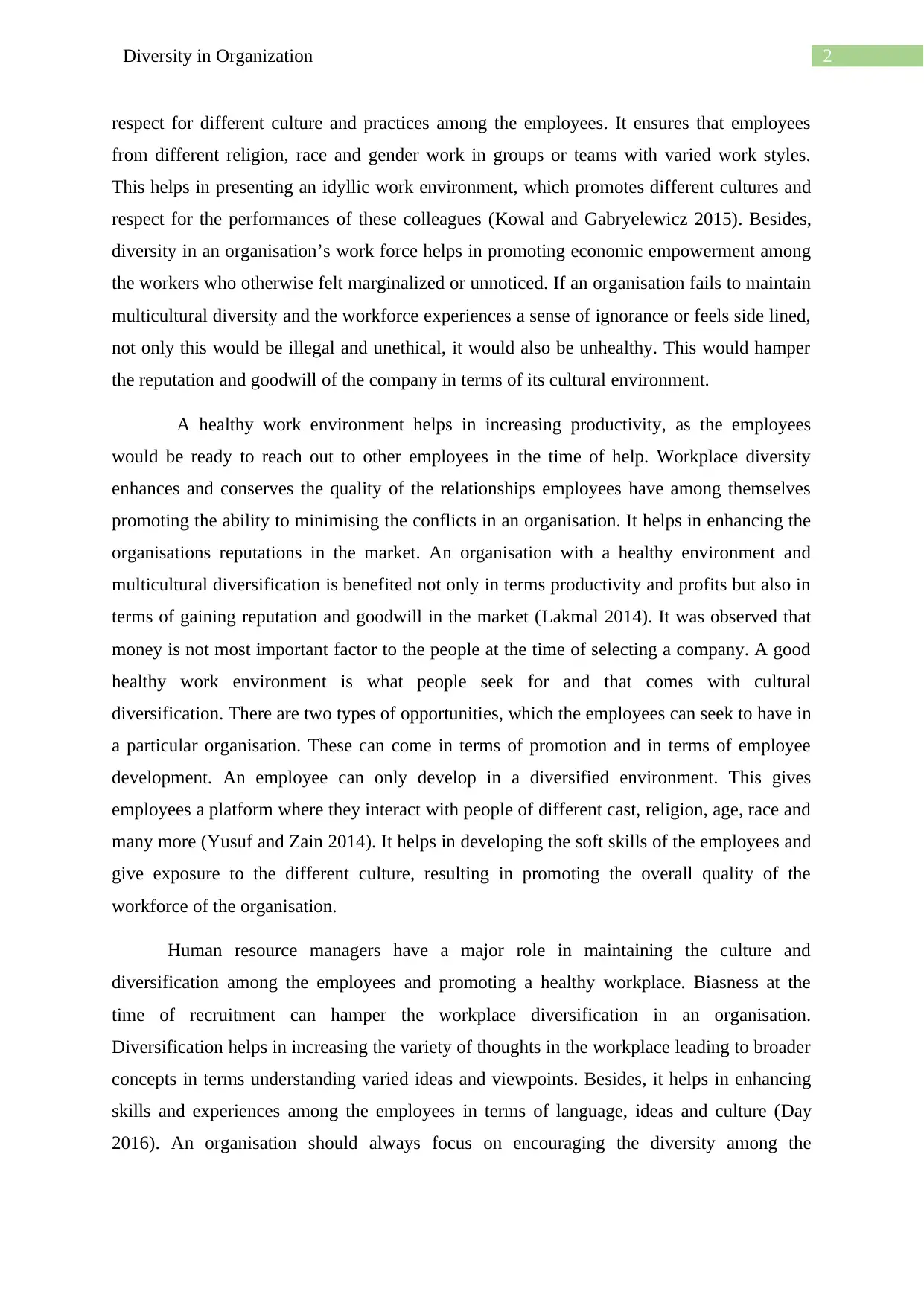
2Diversity in Organization
respect for different culture and practices among the employees. It ensures that employees
from different religion, race and gender work in groups or teams with varied work styles.
This helps in presenting an idyllic work environment, which promotes different cultures and
respect for the performances of these colleagues (Kowal and Gabryelewicz 2015). Besides,
diversity in an organisation’s work force helps in promoting economic empowerment among
the workers who otherwise felt marginalized or unnoticed. If an organisation fails to maintain
multicultural diversity and the workforce experiences a sense of ignorance or feels side lined,
not only this would be illegal and unethical, it would also be unhealthy. This would hamper
the reputation and goodwill of the company in terms of its cultural environment.
A healthy work environment helps in increasing productivity, as the employees
would be ready to reach out to other employees in the time of help. Workplace diversity
enhances and conserves the quality of the relationships employees have among themselves
promoting the ability to minimising the conflicts in an organisation. It helps in enhancing the
organisations reputations in the market. An organisation with a healthy environment and
multicultural diversification is benefited not only in terms productivity and profits but also in
terms of gaining reputation and goodwill in the market (Lakmal 2014). It was observed that
money is not most important factor to the people at the time of selecting a company. A good
healthy work environment is what people seek for and that comes with cultural
diversification. There are two types of opportunities, which the employees can seek to have in
a particular organisation. These can come in terms of promotion and in terms of employee
development. An employee can only develop in a diversified environment. This gives
employees a platform where they interact with people of different cast, religion, age, race and
many more (Yusuf and Zain 2014). It helps in developing the soft skills of the employees and
give exposure to the different culture, resulting in promoting the overall quality of the
workforce of the organisation.
Human resource managers have a major role in maintaining the culture and
diversification among the employees and promoting a healthy workplace. Biasness at the
time of recruitment can hamper the workplace diversification in an organisation.
Diversification helps in increasing the variety of thoughts in the workplace leading to broader
concepts in terms understanding varied ideas and viewpoints. Besides, it helps in enhancing
skills and experiences among the employees in terms of language, ideas and culture (Day
2016). An organisation should always focus on encouraging the diversity among the
respect for different culture and practices among the employees. It ensures that employees
from different religion, race and gender work in groups or teams with varied work styles.
This helps in presenting an idyllic work environment, which promotes different cultures and
respect for the performances of these colleagues (Kowal and Gabryelewicz 2015). Besides,
diversity in an organisation’s work force helps in promoting economic empowerment among
the workers who otherwise felt marginalized or unnoticed. If an organisation fails to maintain
multicultural diversity and the workforce experiences a sense of ignorance or feels side lined,
not only this would be illegal and unethical, it would also be unhealthy. This would hamper
the reputation and goodwill of the company in terms of its cultural environment.
A healthy work environment helps in increasing productivity, as the employees
would be ready to reach out to other employees in the time of help. Workplace diversity
enhances and conserves the quality of the relationships employees have among themselves
promoting the ability to minimising the conflicts in an organisation. It helps in enhancing the
organisations reputations in the market. An organisation with a healthy environment and
multicultural diversification is benefited not only in terms productivity and profits but also in
terms of gaining reputation and goodwill in the market (Lakmal 2014). It was observed that
money is not most important factor to the people at the time of selecting a company. A good
healthy work environment is what people seek for and that comes with cultural
diversification. There are two types of opportunities, which the employees can seek to have in
a particular organisation. These can come in terms of promotion and in terms of employee
development. An employee can only develop in a diversified environment. This gives
employees a platform where they interact with people of different cast, religion, age, race and
many more (Yusuf and Zain 2014). It helps in developing the soft skills of the employees and
give exposure to the different culture, resulting in promoting the overall quality of the
workforce of the organisation.
Human resource managers have a major role in maintaining the culture and
diversification among the employees and promoting a healthy workplace. Biasness at the
time of recruitment can hamper the workplace diversification in an organisation.
Diversification helps in increasing the variety of thoughts in the workplace leading to broader
concepts in terms understanding varied ideas and viewpoints. Besides, it helps in enhancing
skills and experiences among the employees in terms of language, ideas and culture (Day
2016). An organisation should always focus on encouraging the diversity among the
⊘ This is a preview!⊘
Do you want full access?
Subscribe today to unlock all pages.

Trusted by 1+ million students worldwide
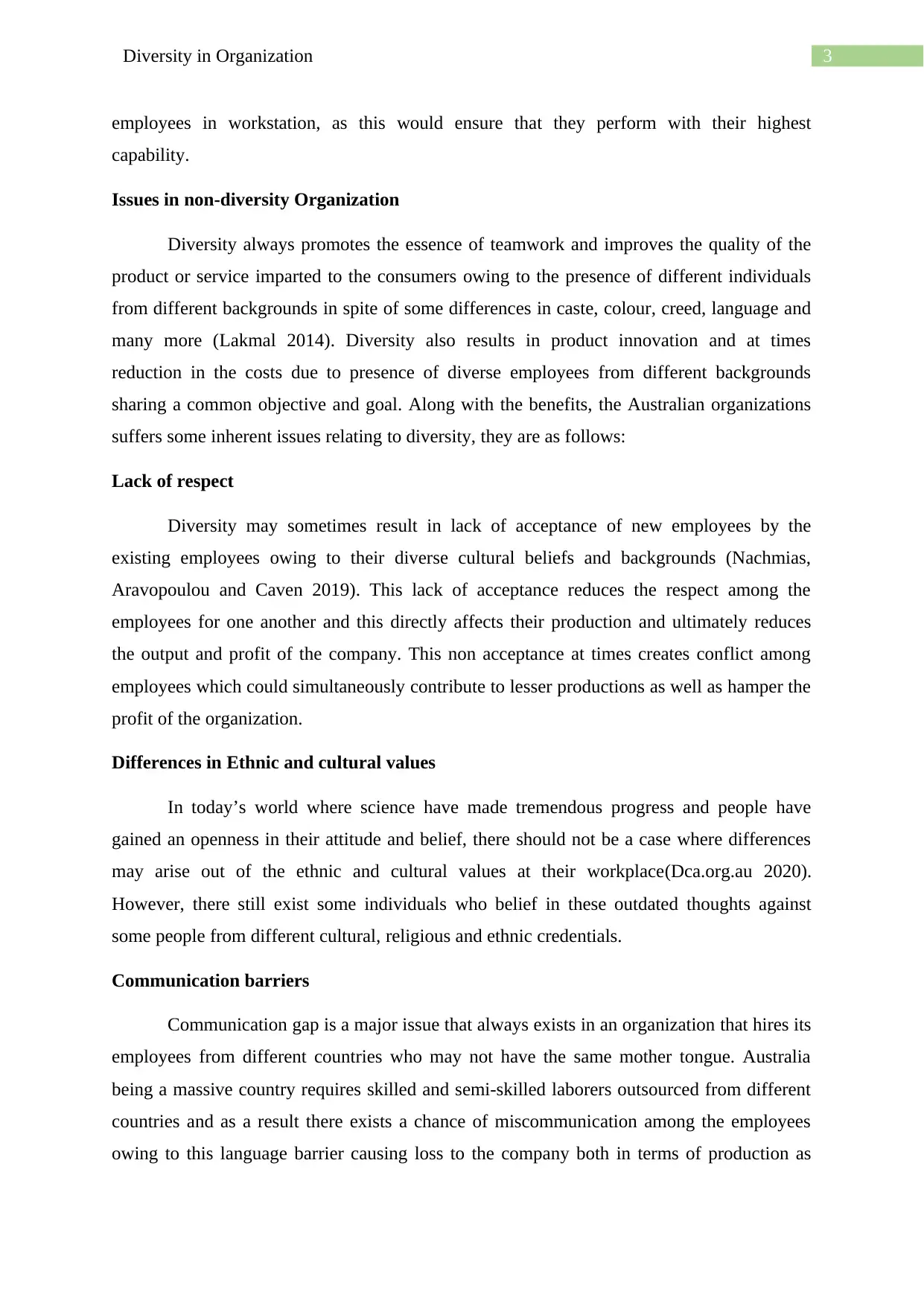
3Diversity in Organization
employees in workstation, as this would ensure that they perform with their highest
capability.
Issues in non-diversity Organization
Diversity always promotes the essence of teamwork and improves the quality of the
product or service imparted to the consumers owing to the presence of different individuals
from different backgrounds in spite of some differences in caste, colour, creed, language and
many more (Lakmal 2014). Diversity also results in product innovation and at times
reduction in the costs due to presence of diverse employees from different backgrounds
sharing a common objective and goal. Along with the benefits, the Australian organizations
suffers some inherent issues relating to diversity, they are as follows:
Lack of respect
Diversity may sometimes result in lack of acceptance of new employees by the
existing employees owing to their diverse cultural beliefs and backgrounds (Nachmias,
Aravopoulou and Caven 2019). This lack of acceptance reduces the respect among the
employees for one another and this directly affects their production and ultimately reduces
the output and profit of the company. This non acceptance at times creates conflict among
employees which could simultaneously contribute to lesser productions as well as hamper the
profit of the organization.
Differences in Ethnic and cultural values
In today’s world where science have made tremendous progress and people have
gained an openness in their attitude and belief, there should not be a case where differences
may arise out of the ethnic and cultural values at their workplace(Dca.org.au 2020).
However, there still exist some individuals who belief in these outdated thoughts against
some people from different cultural, religious and ethnic credentials.
Communication barriers
Communication gap is a major issue that always exists in an organization that hires its
employees from different countries who may not have the same mother tongue. Australia
being a massive country requires skilled and semi-skilled laborers outsourced from different
countries and as a result there exists a chance of miscommunication among the employees
owing to this language barrier causing loss to the company both in terms of production as
employees in workstation, as this would ensure that they perform with their highest
capability.
Issues in non-diversity Organization
Diversity always promotes the essence of teamwork and improves the quality of the
product or service imparted to the consumers owing to the presence of different individuals
from different backgrounds in spite of some differences in caste, colour, creed, language and
many more (Lakmal 2014). Diversity also results in product innovation and at times
reduction in the costs due to presence of diverse employees from different backgrounds
sharing a common objective and goal. Along with the benefits, the Australian organizations
suffers some inherent issues relating to diversity, they are as follows:
Lack of respect
Diversity may sometimes result in lack of acceptance of new employees by the
existing employees owing to their diverse cultural beliefs and backgrounds (Nachmias,
Aravopoulou and Caven 2019). This lack of acceptance reduces the respect among the
employees for one another and this directly affects their production and ultimately reduces
the output and profit of the company. This non acceptance at times creates conflict among
employees which could simultaneously contribute to lesser productions as well as hamper the
profit of the organization.
Differences in Ethnic and cultural values
In today’s world where science have made tremendous progress and people have
gained an openness in their attitude and belief, there should not be a case where differences
may arise out of the ethnic and cultural values at their workplace(Dca.org.au 2020).
However, there still exist some individuals who belief in these outdated thoughts against
some people from different cultural, religious and ethnic credentials.
Communication barriers
Communication gap is a major issue that always exists in an organization that hires its
employees from different countries who may not have the same mother tongue. Australia
being a massive country requires skilled and semi-skilled laborers outsourced from different
countries and as a result there exists a chance of miscommunication among the employees
owing to this language barrier causing loss to the company both in terms of production as
Paraphrase This Document
Need a fresh take? Get an instant paraphrase of this document with our AI Paraphraser
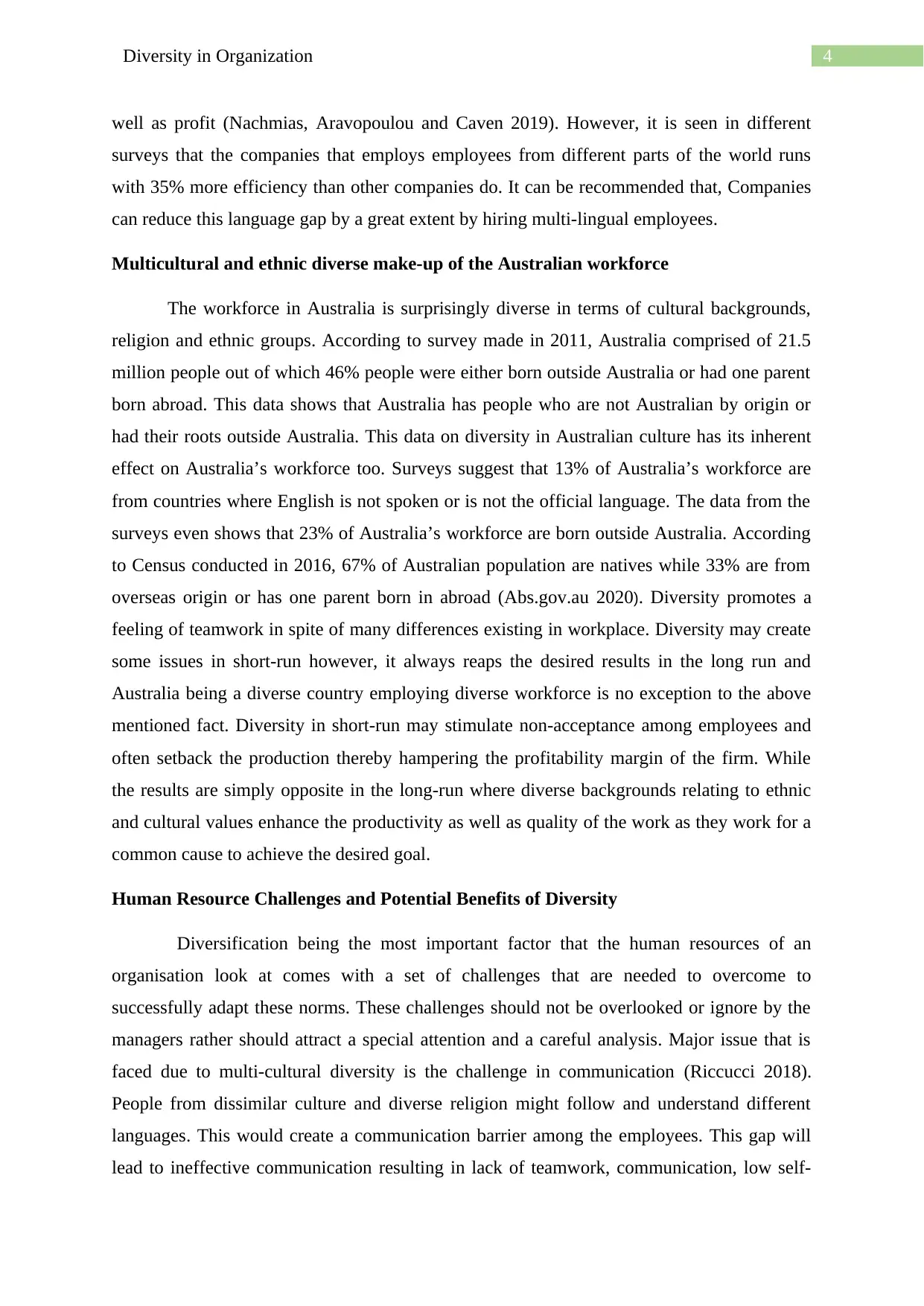
4Diversity in Organization
well as profit (Nachmias, Aravopoulou and Caven 2019). However, it is seen in different
surveys that the companies that employs employees from different parts of the world runs
with 35% more efficiency than other companies do. It can be recommended that, Companies
can reduce this language gap by a great extent by hiring multi-lingual employees.
Multicultural and ethnic diverse make-up of the Australian workforce
The workforce in Australia is surprisingly diverse in terms of cultural backgrounds,
religion and ethnic groups. According to survey made in 2011, Australia comprised of 21.5
million people out of which 46% people were either born outside Australia or had one parent
born abroad. This data shows that Australia has people who are not Australian by origin or
had their roots outside Australia. This data on diversity in Australian culture has its inherent
effect on Australia’s workforce too. Surveys suggest that 13% of Australia’s workforce are
from countries where English is not spoken or is not the official language. The data from the
surveys even shows that 23% of Australia’s workforce are born outside Australia. According
to Census conducted in 2016, 67% of Australian population are natives while 33% are from
overseas origin or has one parent born in abroad (Abs.gov.au 2020). Diversity promotes a
feeling of teamwork in spite of many differences existing in workplace. Diversity may create
some issues in short-run however, it always reaps the desired results in the long run and
Australia being a diverse country employing diverse workforce is no exception to the above
mentioned fact. Diversity in short-run may stimulate non-acceptance among employees and
often setback the production thereby hampering the profitability margin of the firm. While
the results are simply opposite in the long-run where diverse backgrounds relating to ethnic
and cultural values enhance the productivity as well as quality of the work as they work for a
common cause to achieve the desired goal.
Human Resource Challenges and Potential Benefits of Diversity
Diversification being the most important factor that the human resources of an
organisation look at comes with a set of challenges that are needed to overcome to
successfully adapt these norms. These challenges should not be overlooked or ignore by the
managers rather should attract a special attention and a careful analysis. Major issue that is
faced due to multi-cultural diversity is the challenge in communication (Riccucci 2018).
People from dissimilar culture and diverse religion might follow and understand different
languages. This would create a communication barrier among the employees. This gap will
lead to ineffective communication resulting in lack of teamwork, communication, low self-
well as profit (Nachmias, Aravopoulou and Caven 2019). However, it is seen in different
surveys that the companies that employs employees from different parts of the world runs
with 35% more efficiency than other companies do. It can be recommended that, Companies
can reduce this language gap by a great extent by hiring multi-lingual employees.
Multicultural and ethnic diverse make-up of the Australian workforce
The workforce in Australia is surprisingly diverse in terms of cultural backgrounds,
religion and ethnic groups. According to survey made in 2011, Australia comprised of 21.5
million people out of which 46% people were either born outside Australia or had one parent
born abroad. This data shows that Australia has people who are not Australian by origin or
had their roots outside Australia. This data on diversity in Australian culture has its inherent
effect on Australia’s workforce too. Surveys suggest that 13% of Australia’s workforce are
from countries where English is not spoken or is not the official language. The data from the
surveys even shows that 23% of Australia’s workforce are born outside Australia. According
to Census conducted in 2016, 67% of Australian population are natives while 33% are from
overseas origin or has one parent born in abroad (Abs.gov.au 2020). Diversity promotes a
feeling of teamwork in spite of many differences existing in workplace. Diversity may create
some issues in short-run however, it always reaps the desired results in the long run and
Australia being a diverse country employing diverse workforce is no exception to the above
mentioned fact. Diversity in short-run may stimulate non-acceptance among employees and
often setback the production thereby hampering the profitability margin of the firm. While
the results are simply opposite in the long-run where diverse backgrounds relating to ethnic
and cultural values enhance the productivity as well as quality of the work as they work for a
common cause to achieve the desired goal.
Human Resource Challenges and Potential Benefits of Diversity
Diversification being the most important factor that the human resources of an
organisation look at comes with a set of challenges that are needed to overcome to
successfully adapt these norms. These challenges should not be overlooked or ignore by the
managers rather should attract a special attention and a careful analysis. Major issue that is
faced due to multi-cultural diversity is the challenge in communication (Riccucci 2018).
People from dissimilar culture and diverse religion might follow and understand different
languages. This would create a communication barrier among the employees. This gap will
lead to ineffective communication resulting in lack of teamwork, communication, low self-

5Diversity in Organization
esteem and decrease in confidence among the employees. Another major challenge that is
faced due to diversification is the lack of willingness among the employees to adapt to this
diversification. An organisation might have employees who are productive and highly
efficient in their work but when it comes to accepting people from different culture, they are
reluctant to change. These employees have their own certain set of rules, which they are not
ready to alter or modify under any circumstances.
“According to a New York Times report, there are only five African-American CEOs
out of Fortune 500 companies. Furthermore, a University of Wisconsin study revealed that
people with African-American sounding names are 14% less likely to get a call back.” This
shows that even today discrimination is followed and cultural differences are still observed in
many organisation. Even though there are different organisational and government policies
on the ethnic diversification, people still tend to follow discrimination between cultures, cast,
races and religion. Hence, ensuring that these policies are implemented and adhered by every
organisation and its employees is a major challenge (Riccucci 2018). Ensuring diversification
deals with giving equal opportunities to disabled if they are capable and skilled. Often, these
employees need some special attention or additional requirement. These can be as easy as a
wheelchair or as difficult as a peaceful environment. Having a workforce that is supportive to
avoid discrimination or disrespectful remarks and treat these employees with respect and
admiration is a major challenge that can be faced by the organisation and its management.
“By 2025, millennial will make up 75% of the workforce, and they are changing the
work culture.” Diversification ensures that there are employees from all generations
inclusive of fresher and experienced people. Generation gap means the gap between the
senior or existing employees and the new appointed fresher (Asheim Grillitsch and Trippl
2017). Organisation nowadays consist of young workforce that implement new effective
working technique instead of following the old traditional ones. Existing employees might
face difficulties in coping to these changes. This may lead to formation of different groups or
teams of same generation. Bringing together the employees of different generation to one
single group is a key challenge faced by the human resource managers of the organisation.
Human Resource Practices Adopted in Organization to manage diversity
The human resource practices which is mentioned below helps the organization to manage
diversity and lower the discrimination practice in the organization. It is reported that around
93% of the organizations possess zero-tolerance level on the workplace discrimination during
esteem and decrease in confidence among the employees. Another major challenge that is
faced due to diversification is the lack of willingness among the employees to adapt to this
diversification. An organisation might have employees who are productive and highly
efficient in their work but when it comes to accepting people from different culture, they are
reluctant to change. These employees have their own certain set of rules, which they are not
ready to alter or modify under any circumstances.
“According to a New York Times report, there are only five African-American CEOs
out of Fortune 500 companies. Furthermore, a University of Wisconsin study revealed that
people with African-American sounding names are 14% less likely to get a call back.” This
shows that even today discrimination is followed and cultural differences are still observed in
many organisation. Even though there are different organisational and government policies
on the ethnic diversification, people still tend to follow discrimination between cultures, cast,
races and religion. Hence, ensuring that these policies are implemented and adhered by every
organisation and its employees is a major challenge (Riccucci 2018). Ensuring diversification
deals with giving equal opportunities to disabled if they are capable and skilled. Often, these
employees need some special attention or additional requirement. These can be as easy as a
wheelchair or as difficult as a peaceful environment. Having a workforce that is supportive to
avoid discrimination or disrespectful remarks and treat these employees with respect and
admiration is a major challenge that can be faced by the organisation and its management.
“By 2025, millennial will make up 75% of the workforce, and they are changing the
work culture.” Diversification ensures that there are employees from all generations
inclusive of fresher and experienced people. Generation gap means the gap between the
senior or existing employees and the new appointed fresher (Asheim Grillitsch and Trippl
2017). Organisation nowadays consist of young workforce that implement new effective
working technique instead of following the old traditional ones. Existing employees might
face difficulties in coping to these changes. This may lead to formation of different groups or
teams of same generation. Bringing together the employees of different generation to one
single group is a key challenge faced by the human resource managers of the organisation.
Human Resource Practices Adopted in Organization to manage diversity
The human resource practices which is mentioned below helps the organization to manage
diversity and lower the discrimination practice in the organization. It is reported that around
93% of the organizations possess zero-tolerance level on the workplace discrimination during
⊘ This is a preview!⊘
Do you want full access?
Subscribe today to unlock all pages.

Trusted by 1+ million students worldwide
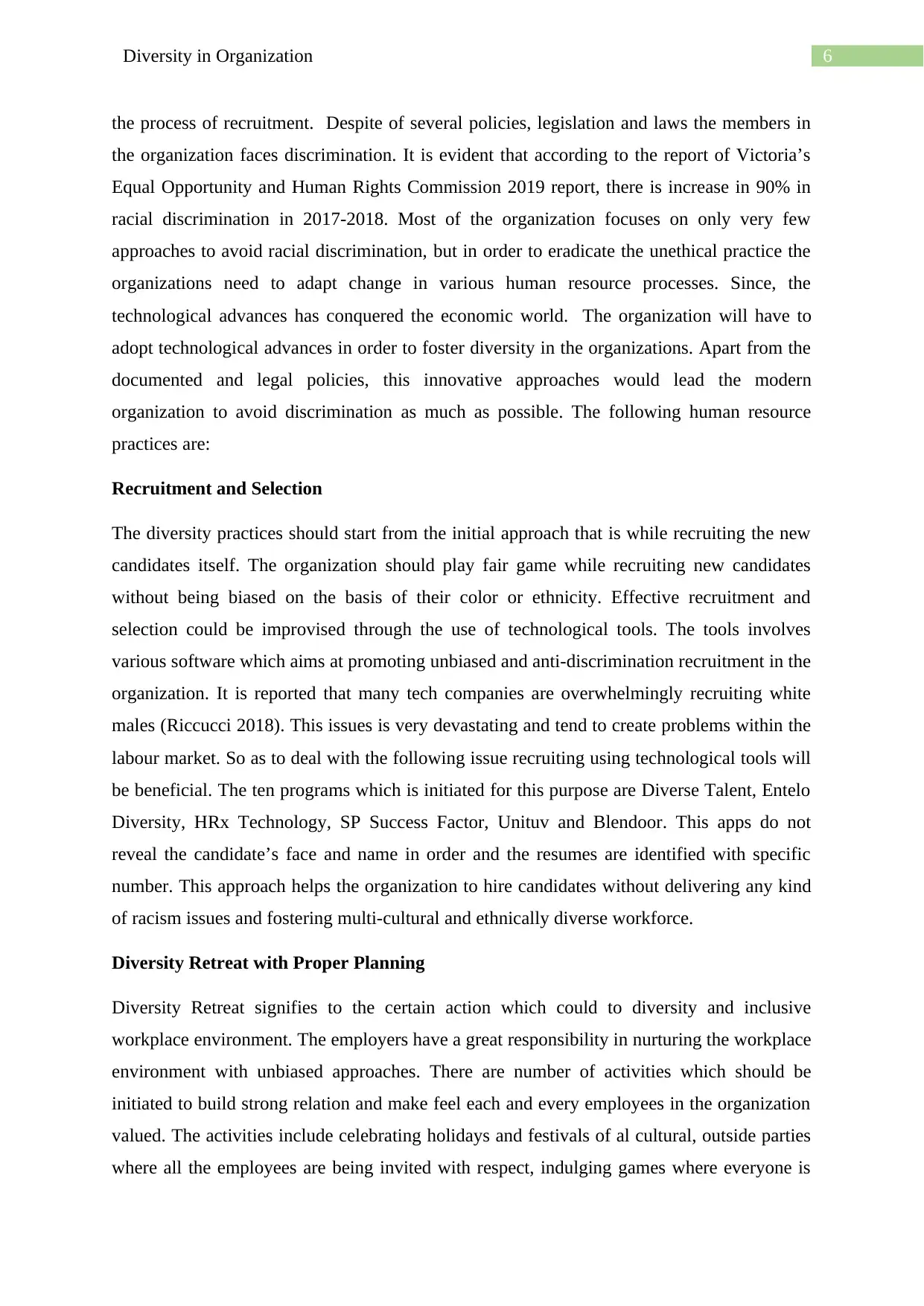
6Diversity in Organization
the process of recruitment. Despite of several policies, legislation and laws the members in
the organization faces discrimination. It is evident that according to the report of Victoria’s
Equal Opportunity and Human Rights Commission 2019 report, there is increase in 90% in
racial discrimination in 2017-2018. Most of the organization focuses on only very few
approaches to avoid racial discrimination, but in order to eradicate the unethical practice the
organizations need to adapt change in various human resource processes. Since, the
technological advances has conquered the economic world. The organization will have to
adopt technological advances in order to foster diversity in the organizations. Apart from the
documented and legal policies, this innovative approaches would lead the modern
organization to avoid discrimination as much as possible. The following human resource
practices are:
Recruitment and Selection
The diversity practices should start from the initial approach that is while recruiting the new
candidates itself. The organization should play fair game while recruiting new candidates
without being biased on the basis of their color or ethnicity. Effective recruitment and
selection could be improvised through the use of technological tools. The tools involves
various software which aims at promoting unbiased and anti-discrimination recruitment in the
organization. It is reported that many tech companies are overwhelmingly recruiting white
males (Riccucci 2018). This issues is very devastating and tend to create problems within the
labour market. So as to deal with the following issue recruiting using technological tools will
be beneficial. The ten programs which is initiated for this purpose are Diverse Talent, Entelo
Diversity, HRx Technology, SP Success Factor, Unituv and Blendoor. This apps do not
reveal the candidate’s face and name in order and the resumes are identified with specific
number. This approach helps the organization to hire candidates without delivering any kind
of racism issues and fostering multi-cultural and ethnically diverse workforce.
Diversity Retreat with Proper Planning
Diversity Retreat signifies to the certain action which could to diversity and inclusive
workplace environment. The employers have a great responsibility in nurturing the workplace
environment with unbiased approaches. There are number of activities which should be
initiated to build strong relation and make feel each and every employees in the organization
valued. The activities include celebrating holidays and festivals of al cultural, outside parties
where all the employees are being invited with respect, indulging games where everyone is
the process of recruitment. Despite of several policies, legislation and laws the members in
the organization faces discrimination. It is evident that according to the report of Victoria’s
Equal Opportunity and Human Rights Commission 2019 report, there is increase in 90% in
racial discrimination in 2017-2018. Most of the organization focuses on only very few
approaches to avoid racial discrimination, but in order to eradicate the unethical practice the
organizations need to adapt change in various human resource processes. Since, the
technological advances has conquered the economic world. The organization will have to
adopt technological advances in order to foster diversity in the organizations. Apart from the
documented and legal policies, this innovative approaches would lead the modern
organization to avoid discrimination as much as possible. The following human resource
practices are:
Recruitment and Selection
The diversity practices should start from the initial approach that is while recruiting the new
candidates itself. The organization should play fair game while recruiting new candidates
without being biased on the basis of their color or ethnicity. Effective recruitment and
selection could be improvised through the use of technological tools. The tools involves
various software which aims at promoting unbiased and anti-discrimination recruitment in the
organization. It is reported that many tech companies are overwhelmingly recruiting white
males (Riccucci 2018). This issues is very devastating and tend to create problems within the
labour market. So as to deal with the following issue recruiting using technological tools will
be beneficial. The ten programs which is initiated for this purpose are Diverse Talent, Entelo
Diversity, HRx Technology, SP Success Factor, Unituv and Blendoor. This apps do not
reveal the candidate’s face and name in order and the resumes are identified with specific
number. This approach helps the organization to hire candidates without delivering any kind
of racism issues and fostering multi-cultural and ethnically diverse workforce.
Diversity Retreat with Proper Planning
Diversity Retreat signifies to the certain action which could to diversity and inclusive
workplace environment. The employers have a great responsibility in nurturing the workplace
environment with unbiased approaches. There are number of activities which should be
initiated to build strong relation and make feel each and every employees in the organization
valued. The activities include celebrating holidays and festivals of al cultural, outside parties
where all the employees are being invited with respect, indulging games where everyone is
Paraphrase This Document
Need a fresh take? Get an instant paraphrase of this document with our AI Paraphraser

7Diversity in Organization
allowed to participate. The initiatives might be a normal approach but it does has great
significance and relevance. This approaches helps the individuals to understand each other
culture, respect them and fill the multicultural gap.
Training and Development
It is evident that according to Australian Centre for International Business in overall there are
only 27% of organizations which provide training on diversity. The training promotes
awareness on the advantages on promoting diversity and inclusiveness within the workplace
and the possible issues related to discrimination (Riccucci 2018). This would allow the
members of the organization to broaden their minds and think beyond the walls. According to
A. Gillert and G. Chuzischvili believed that traditional way of training is no sufficient for the
employees and employers and therefore, actual examples and modern initiatives should be
reflected in the training programs (Syed and Ozbilgin 2019).
No-judgmental coaching which deliberately focuses on listening actively and on asking
question so as to understand each and every individual and understand the concept of self-
awareness. According to a study conducted by P. Schmidt it is said that “all diversity training
is about self-awareness”.
It is concluded from the above discussion that the multi-culture and ethnicity are the
most important factors which needs to be nurtured in the organization. Diversified
organization bring productivity, reputation and increased value for the company. Apart from
business ethics, diversity has fostered improved performance in the organization. The paper
has reflected the various challenges such as The various approaches that would helps the
organization to help the management to build diversity is effective recruitment and selection,
training and development and diversity retreat. This approaches has not only improved the
organization performance but also increased the value of employees in organizations.
allowed to participate. The initiatives might be a normal approach but it does has great
significance and relevance. This approaches helps the individuals to understand each other
culture, respect them and fill the multicultural gap.
Training and Development
It is evident that according to Australian Centre for International Business in overall there are
only 27% of organizations which provide training on diversity. The training promotes
awareness on the advantages on promoting diversity and inclusiveness within the workplace
and the possible issues related to discrimination (Riccucci 2018). This would allow the
members of the organization to broaden their minds and think beyond the walls. According to
A. Gillert and G. Chuzischvili believed that traditional way of training is no sufficient for the
employees and employers and therefore, actual examples and modern initiatives should be
reflected in the training programs (Syed and Ozbilgin 2019).
No-judgmental coaching which deliberately focuses on listening actively and on asking
question so as to understand each and every individual and understand the concept of self-
awareness. According to a study conducted by P. Schmidt it is said that “all diversity training
is about self-awareness”.
It is concluded from the above discussion that the multi-culture and ethnicity are the
most important factors which needs to be nurtured in the organization. Diversified
organization bring productivity, reputation and increased value for the company. Apart from
business ethics, diversity has fostered improved performance in the organization. The paper
has reflected the various challenges such as The various approaches that would helps the
organization to help the management to build diversity is effective recruitment and selection,
training and development and diversity retreat. This approaches has not only improved the
organization performance but also increased the value of employees in organizations.
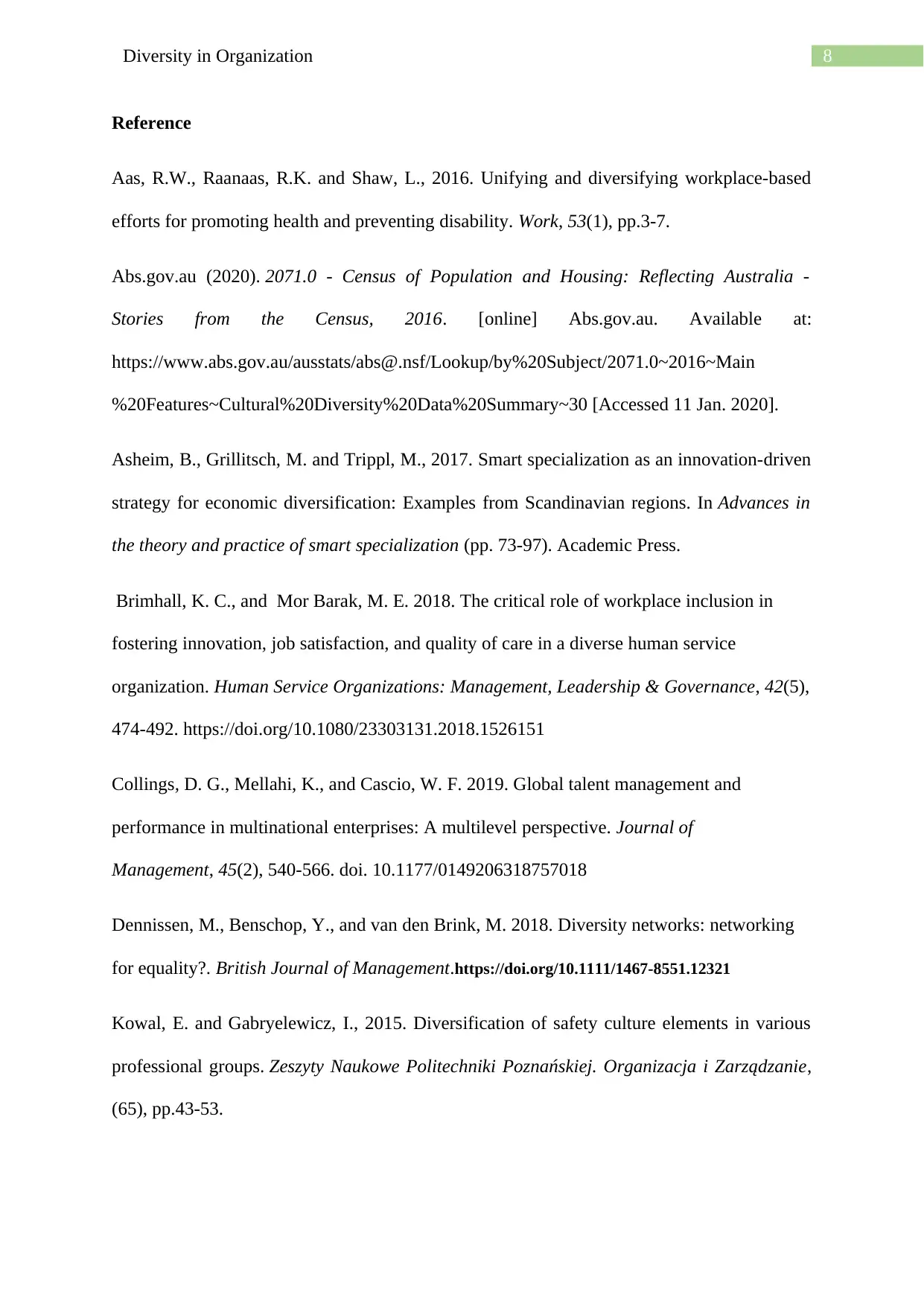
8Diversity in Organization
Reference
Aas, R.W., Raanaas, R.K. and Shaw, L., 2016. Unifying and diversifying workplace-based
efforts for promoting health and preventing disability. Work, 53(1), pp.3-7.
Abs.gov.au (2020). 2071.0 - Census of Population and Housing: Reflecting Australia -
Stories from the Census, 2016. [online] Abs.gov.au. Available at:
https://www.abs.gov.au/ausstats/abs@.nsf/Lookup/by%20Subject/2071.0~2016~Main
%20Features~Cultural%20Diversity%20Data%20Summary~30 [Accessed 11 Jan. 2020].
Asheim, B., Grillitsch, M. and Trippl, M., 2017. Smart specialization as an innovation-driven
strategy for economic diversification: Examples from Scandinavian regions. In Advances in
the theory and practice of smart specialization (pp. 73-97). Academic Press.
Brimhall, K. C., and Mor Barak, M. E. 2018. The critical role of workplace inclusion in
fostering innovation, job satisfaction, and quality of care in a diverse human service
organization. Human Service Organizations: Management, Leadership & Governance, 42(5),
474-492. https://doi.org/10.1080/23303131.2018.1526151
Collings, D. G., Mellahi, K., and Cascio, W. F. 2019. Global talent management and
performance in multinational enterprises: A multilevel perspective. Journal of
Management, 45(2), 540-566. doi. 10.1177/0149206318757018
Dennissen, M., Benschop, Y., and van den Brink, M. 2018. Diversity networks: networking
for equality?. British Journal of Management.https://doi.org/10.1111/1467-8551.12321
Kowal, E. and Gabryelewicz, I., 2015. Diversification of safety culture elements in various
professional groups. Zeszyty Naukowe Politechniki Poznańskiej. Organizacja i Zarządzanie,
(65), pp.43-53.
Reference
Aas, R.W., Raanaas, R.K. and Shaw, L., 2016. Unifying and diversifying workplace-based
efforts for promoting health and preventing disability. Work, 53(1), pp.3-7.
Abs.gov.au (2020). 2071.0 - Census of Population and Housing: Reflecting Australia -
Stories from the Census, 2016. [online] Abs.gov.au. Available at:
https://www.abs.gov.au/ausstats/abs@.nsf/Lookup/by%20Subject/2071.0~2016~Main
%20Features~Cultural%20Diversity%20Data%20Summary~30 [Accessed 11 Jan. 2020].
Asheim, B., Grillitsch, M. and Trippl, M., 2017. Smart specialization as an innovation-driven
strategy for economic diversification: Examples from Scandinavian regions. In Advances in
the theory and practice of smart specialization (pp. 73-97). Academic Press.
Brimhall, K. C., and Mor Barak, M. E. 2018. The critical role of workplace inclusion in
fostering innovation, job satisfaction, and quality of care in a diverse human service
organization. Human Service Organizations: Management, Leadership & Governance, 42(5),
474-492. https://doi.org/10.1080/23303131.2018.1526151
Collings, D. G., Mellahi, K., and Cascio, W. F. 2019. Global talent management and
performance in multinational enterprises: A multilevel perspective. Journal of
Management, 45(2), 540-566. doi. 10.1177/0149206318757018
Dennissen, M., Benschop, Y., and van den Brink, M. 2018. Diversity networks: networking
for equality?. British Journal of Management.https://doi.org/10.1111/1467-8551.12321
Kowal, E. and Gabryelewicz, I., 2015. Diversification of safety culture elements in various
professional groups. Zeszyty Naukowe Politechniki Poznańskiej. Organizacja i Zarządzanie,
(65), pp.43-53.
⊘ This is a preview!⊘
Do you want full access?
Subscribe today to unlock all pages.

Trusted by 1+ million students worldwide
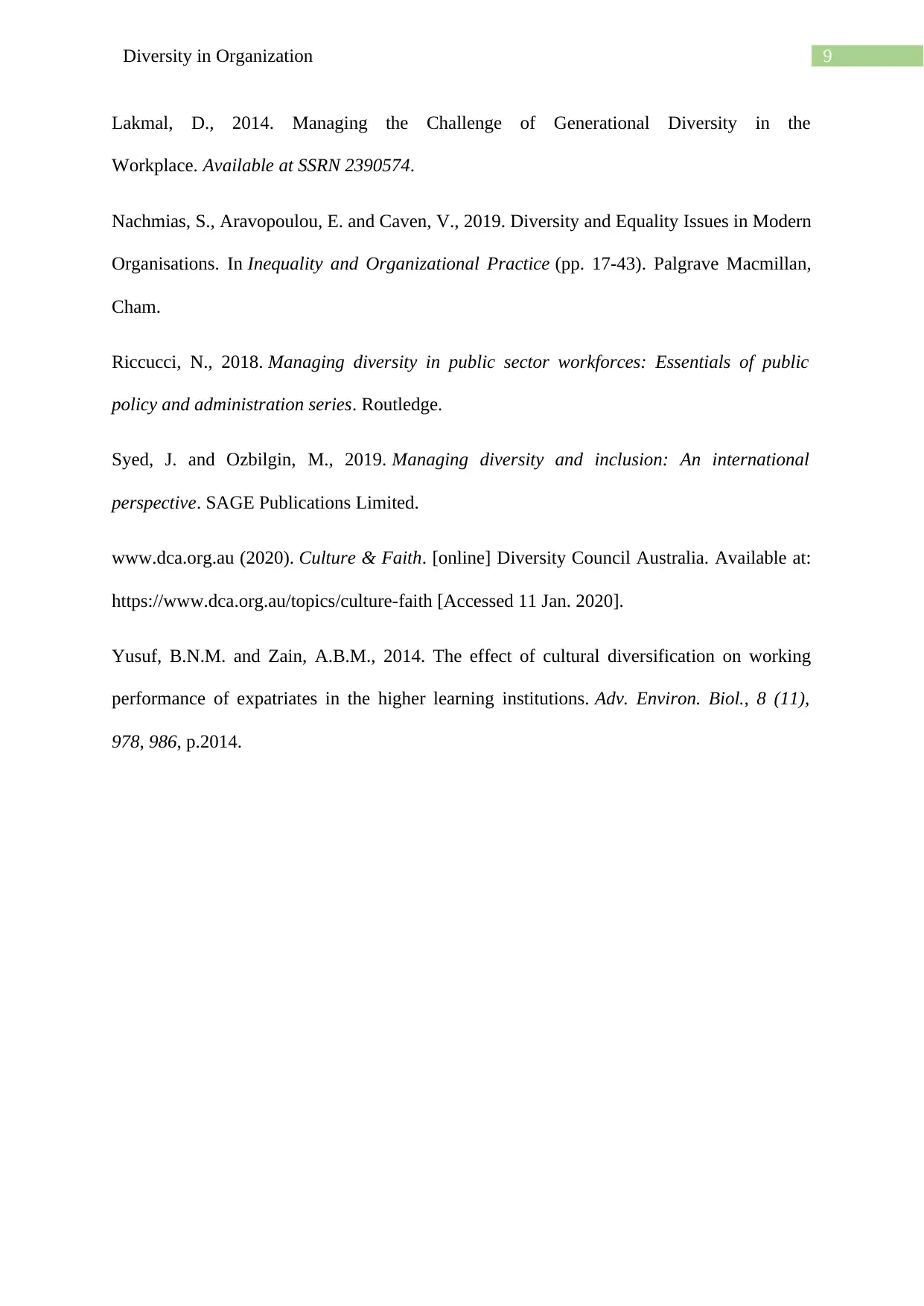
9Diversity in Organization
Lakmal, D., 2014. Managing the Challenge of Generational Diversity in the
Workplace. Available at SSRN 2390574.
Nachmias, S., Aravopoulou, E. and Caven, V., 2019. Diversity and Equality Issues in Modern
Organisations. In Inequality and Organizational Practice (pp. 17-43). Palgrave Macmillan,
Cham.
Riccucci, N., 2018. Managing diversity in public sector workforces: Essentials of public
policy and administration series. Routledge.
Syed, J. and Ozbilgin, M., 2019. Managing diversity and inclusion: An international
perspective. SAGE Publications Limited.
www.dca.org.au (2020). Culture & Faith. [online] Diversity Council Australia. Available at:
https://www.dca.org.au/topics/culture-faith [Accessed 11 Jan. 2020].
Yusuf, B.N.M. and Zain, A.B.M., 2014. The effect of cultural diversification on working
performance of expatriates in the higher learning institutions. Adv. Environ. Biol., 8 (11),
978, 986, p.2014.
Lakmal, D., 2014. Managing the Challenge of Generational Diversity in the
Workplace. Available at SSRN 2390574.
Nachmias, S., Aravopoulou, E. and Caven, V., 2019. Diversity and Equality Issues in Modern
Organisations. In Inequality and Organizational Practice (pp. 17-43). Palgrave Macmillan,
Cham.
Riccucci, N., 2018. Managing diversity in public sector workforces: Essentials of public
policy and administration series. Routledge.
Syed, J. and Ozbilgin, M., 2019. Managing diversity and inclusion: An international
perspective. SAGE Publications Limited.
www.dca.org.au (2020). Culture & Faith. [online] Diversity Council Australia. Available at:
https://www.dca.org.au/topics/culture-faith [Accessed 11 Jan. 2020].
Yusuf, B.N.M. and Zain, A.B.M., 2014. The effect of cultural diversification on working
performance of expatriates in the higher learning institutions. Adv. Environ. Biol., 8 (11),
978, 986, p.2014.
1 out of 10
Related Documents
Your All-in-One AI-Powered Toolkit for Academic Success.
+13062052269
info@desklib.com
Available 24*7 on WhatsApp / Email
![[object Object]](/_next/static/media/star-bottom.7253800d.svg)
Unlock your academic potential
Copyright © 2020–2025 A2Z Services. All Rights Reserved. Developed and managed by ZUCOL.





